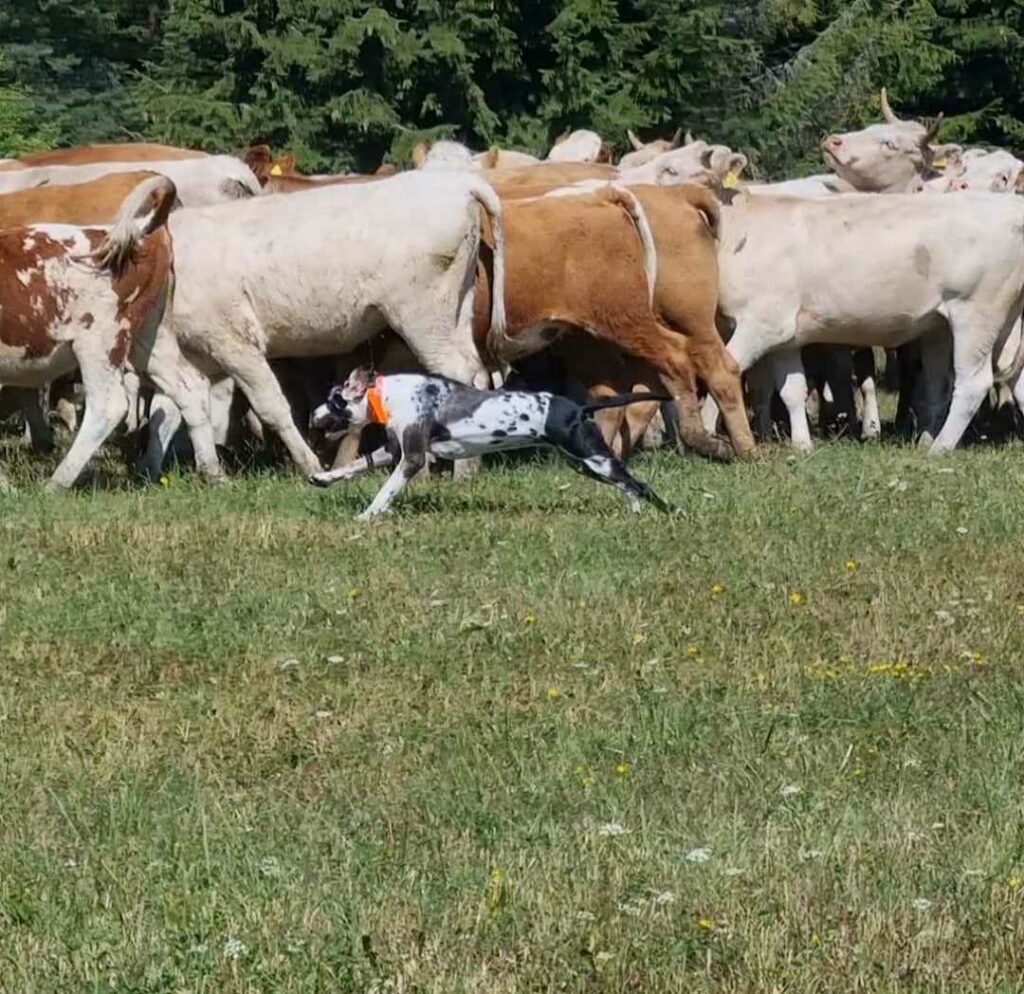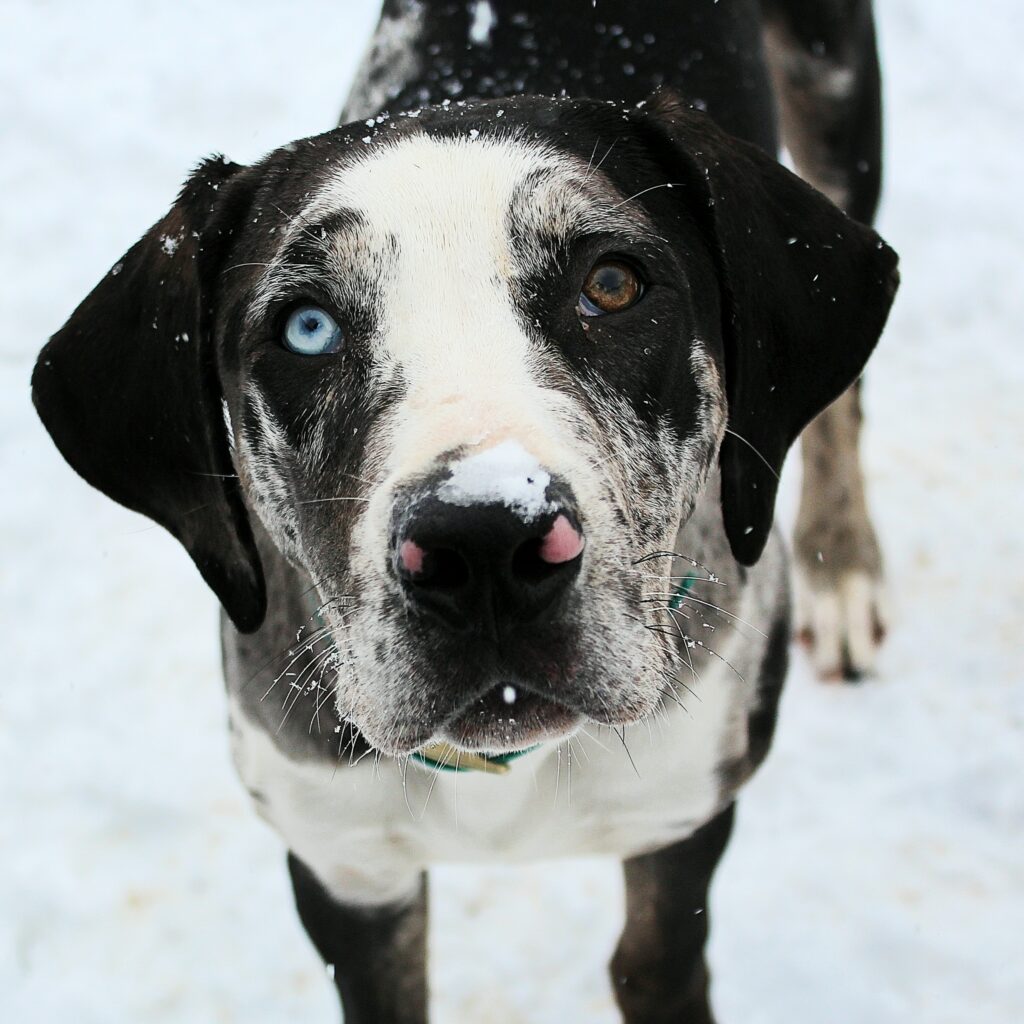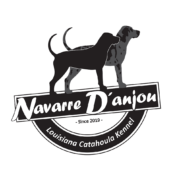ABOUT LOUISIANA CATAHOULA
History of the breed
Don Abney was president of several American dog clubs, leopard dog breeder, versatile dog training trainer, was the author several books dedicated to the law by a leopard dog… That’s why I chose a chapter from history from his pen.
Once called „Catahoula Cur“, base Louisiana Catahoula Leopard The Great Dane arose from random breeding and from some planned breeding. Indians in and around Louisiana they used the red wolf, which then roamed Louisiana during this period, to locate game, much like hunters do today they use their dogs. Hernando De Soto traveled from Florida to Louisiana and brought with him „dogs of war“ who made the journey to the New World. Breeds that were referred to as war dogs, were greyhound and mastiff. Research has shown that a mastiff dog, accompanying him was probably a dog known as the „Alano Mastiff“ from Spain, which is now extinct. These mastiffs had a reputation for being able to pull down very large game with ease. De Soto used their skills to he convinced the Indians to provide information about the location of the gold and treasure. After being defeated in battle, De Soto left his war dogs, who were allowed to roam free. They multiplied and crossed with each other together with the red wolf. Offspring of different breeds was then used by the Indians and became known as „wolf dogs“. The name of the wolf dog mentioned in Louisiana history as even in most history books covering this period, they were given by Henri Tonti during one of his visits in Louisiana. In the early 1700s, the French began coming to Louisiana. The french who heard the stories of Tonti about the abundance of game in Louisiana, they brought with them a dog known as “Bas Rouge“. This dog was also called „Berger de Beauce.“ Today this dog is known as beauceron. The French crossed his dogs with the Indian wolfhound and together they contributed to the creation of catahoulas, that we know today.
Before the registry was created, there were three different versions of the catahoul that differed in size and color. These lines of dogs were known as the Wright, McMillin lines and Fairbanks.
Mr. Preston Wright’s line was the largest of the three and represented dogs originally produced by dogs De Soto. His dogs ranged in weight from 90 to 110 pounds.
Mr. T. A. McMillin, who lived on Sandy Lake, mainly bred dogs called of a blue leopard with glass eyes. The weight of these dogs ranged between dzi 50 and 60 pounds.
From the line of Mr. Love Fairbanks, there were brindle and yellow dogs. His line was not as large as the Wright dogs, but larger than the McMillin line. Weight dogs from this line ranged between 65 and 75 pounds.

These individual lines no longer exist today due to interbreeding, which is the reason so many differences in the size and appearance of the catahoula. Ranchers seem to prefer smaller stature and smaller dogs, while some hunters prefer larger dogs. Most of the stories around catahoul started around 1850 until today. These stories tell of what a great hunting and social dog the catahoula was. Here’s how catahoula came to be versatile dog that he is and why those older breeders and hunters (commonly referred to as „ancients“) took a liking to such tough attitude towards your dogs. Their attitude was so firm that the only way to you could get a catahoula by waiting for someone to give it to you. Catahoulas weren’t sold back then and they used them only those who needed them for hunting or work. From what you read here, you are some of you will think that the practices used were cruel, but try your best reading this article keep it open mind. Many thanks to all of them to the „old people“ and their children for that I was told about these things, so let’s look at this bit of history.
Back in those days, a dollar was worth a dollar and mostly hard to come by. Most families not only worked on full time but generally worked on their farms and ranches others, just to earn money- ze and put food on the table. The family dog was not just a pet, like him we know today. If it didn’t work or it had no function in everyday life on the farm, it was basically useless. It cost money to feed a dog, and if you didn’t earn a living, there was no reason to keep him alive. Those people who used dogs to hunt, they kept a few dogs for hunting and breeding Breeding was to replace dogs, which were lost during hunting or were used in trading for other necessary things. Hunters used a method that was effective in production the best hunting dogs. If the if this method were used today, it would raise cries of cruelty from animal rights activists.
The method was called „Culling“ or „Lining“. Method The „lining“ consisted in the fact that the owner he found a place where he knew the deer delays. He brought himself to this place the entire litter at the age of approximately 6 months. The dogs were lured to follow the deer and then released them as a pack. The last two who crossed the boundary of the place found by the owner were shot. The reason was that the dogs did not show sufficient interest to carry out his work. The rest of the litter could devote itself tracking or reporting a find deer tracks. When they returned, the first two to cross the boundary of the place were also shot. The reason was that they did not show enough interest to stay with clamp.

The remaining dogs were considered the most more promising and would be raised to adulthood and put to work. This practice continued from season to season and from litter to litter. It was ensured that on only the best were kept for hunting and breeding dogs. Hunting in those days was not just a sport. It put the food on the table. Working with a dog on the ranch meant that you don’t have to pay someone who will help with foraging or herding cattle. There was no point in breeding and feeding a dog that couldn’t do the job and he didn’t do her well. My reason for telling this story is to answer those of you who are they ask the question, “What makes the catahoula so versatile?” The answer is that these dogs were so highly selected that only the best of the best remain. Today we see that in the dogs we own. It is an unfortunate fact that this many good ones have been killed by the method dogs, but she improved working and hunting dogs the line of dogs that remained. It can be difficult to understand their reasoning for some of the things that were done, but they were done the best they could with what they had and it worked for them at the time. If you ever get the chance to talk to old catahoula or cur owners, you’ll hear stories that help you understand what they are looking for the dog. They are not pretty eyes either unique coat pattern, not even color combinations. They are looking for a dog that works, or, as they often say, „worth its salt“. They don’t want to see catahoula end like some other groups hunting/working dogs. And those those of us who love this breed want keep these properties alive and thriving.
Character and exterior
The Catahoula is a very tenacious, stubborn and independent breed. He thinks on his own and won’t give you anything for free.
He puts his best into everything and most of all your heart.
He is very territorial, that is it protects its territory and especially its own family — pack.
He chooses his master and is devoted to him to the maximum, but that doesn’t mean he can’t respect other family members. To strangers to people he is measured, reserved, but it is not a rule.


He has a very good one memory and is intelligent enough. In the country of origin USA, it is work breed and is used for hunting raccoons and squirrels, he can climb behind them on a tree. It also proved itself in wild boar hunting, deer and also as a helper in driving cattle.
Here in Europe, it mostly fulfills the role of a companion. In terms of exterior, they are classified as medium-sized breeds, but they are different in type. Some have an athletic figure, long legs and other wide frame, so they are stocky with shorter legs. A lot of times I also encounter an atypical appearance or a significant difference between individuals.

I have two females between which there is a difference in height 10 cm and weighing 10 kg. One has ears shorter and the other longer, one has a beautiful massive head and the other has head smaller. That’s an example of how it is this breed constant.
The head should be massive with pronounced cheek muscles, the crown flat and ideally in the shape of a heart. Overall it has head to match the type of skeleton.
There are ears close-fitting, overhanging and of medium length, they should be properly fitted and not loose.
Eye color is different. It moves ranging from amber, brown, green, blue, glass eyes (glass eyes) up to to different combinations of colors in the eye, but- because each eye is a different color.
Neither the nose nor the eyelids need to be completely pigmented.
The dentition is preferably complete, but the absence of certain teeth is not a defect.
The bite is firm, it can be scissor or level (pincer).
The chest should be deeper with a clearly visible forechest. Back straight and muscular. The legs should be firm, well-muscled and correctly angulated. The tail is long, straight, should be properly fitted and worn upwards. There may be more bent but not touching the back. The coat is short and variously colored.

Thanks to the merle gene, the range of colors is real very wide. Solid — that is, one color. Here we meet we melt with black, red, dark brown — chocolate, blue, yellow sable and heather color. Signs are tan and brindle, may also have white marks, edges — Trim. Thanks to genetics through the test, we will find out that even a single-colored catahoula can be a carrier of the merle gene, even a double one, so it is important to test these dogs as well. Blue leopard — can be with tan or brindle. Blue or even black leopard coloring darkens over time, with age up to black, but this does not apply to all leopard colors. So you buy a beautiful spotted puppy with a light gray background and later you have it at home almost a black dog.
Red leopard, red to brown spots, lighter to darker.



Spotted, tweed (Patchwork) The background is mostly white with map-like, patches spots of various sizes and colors, for example black and white, red, brown, blue (grey) but also tricolor.
Double merle Harlequin we observe on individuals that have a lot of white color, large areas, for example, on the head, ears, chest, which can cause unilateral or bilateral deafness, or an eye defect. But it’s not always like that..
My advice and experience on the nature of this stunning all-rounder breed is that you don’t believe what you read on social networks. I have read many times, that dog bit the child, or growled, or is unmanageable.. In the first advice, when I want to buy a dog, any breed, I have to prepare for it family, child and environment. Children should know how to handle a dog, or any animal. I never- we will learn the truth why the dog really bit or wanted to attack. The fault is automatically assigned to the dog. Catahoula is a dog that needs to be trained consistently, set clear for him rules and boundaries. But it is necessary with every dog, right?

A big role is played by the breeder and then the owner. There are dogs they need socialize more, and he should the breeder can see the puppies. I am not saying that this breed is the ideal family dog, but under the right guidance, can be a great companion. They are sensitive sensitive dogs and when the owner does not pay enough attention to them, a problem can arise in the form of fear aggression. I meet people who are afraid of their leopard, so the dog growls at the bowl, in bed, or when they want something from him that he refuses…
The problem is with the owner, because the dog doesn’t have respect before him and he has no given boundaries. It is necessary to talk about these problems and seek advice as soon as possible.
This problem occurs mainly during puberty and is also affected by hormones nal change. This period brings sometimes stress, uncertainty, despair, because your lovely puppy is suddenly gone becomes an uncontrollable tank. Suddenly he doesn’t know the command, as if he doesn’t hear, he won’t come when summoned, runs after a cyclist or a car, etc.
No need despair, after the hormones have stabilized and the you will find out about her education right from the day on day that you have a great obedient and again the hearing dog.
Try to be positive and don’t stress your dog during puberty.
When choosing a puppy, watch the mother how she treats her puppies, It is very important. Ask the breeder why he chose a particular dog the father of the puppies. Ask how the puppy socializes, try to take the puppy on hands and see for yourself if he is afraid, for example touch. If so, you know that the breeder is probably neglecting the social contact that these dogs need.
This breed has many uses. First of all, it is used for chasing livestock, hunting and tracking searching. Driving cattle or herding sheep.
Since they have an excellent sense of smell, they use used to search for people, namely rubble, surface, water and avalanche. They are also excellent in Nosework! For their Endurance and Strength are good for different sports such as canicross, bikejoring, scooterjoring, dogtrekking, coursing, agility, dogdancing…


They are great defense and guard dogs and excellent companions at the same time. The future owner of a catahoula should realize that this dog is active, therefore it requires the owner’s time, who will devote enough time to it. It’s not a dog which you leave in the garden and here you put him out there, he needs attention.
Many people are attracted by its coloring and blue eyes, and that’s why you wear it they want to buy. I understand that it is an attractive breed, but believe me after a while you don’t care what color it is your darling eyes or spots because you love his soul ♥️
Registered Catahoulas are in NALC
(National Association of Louisiana Catahoulas)
https://www.nalc-inc.org/
in our Slovakia club
https://www.kchmpp.sk/
in Europe club EALC (European Association of Louisiana Catahoulas)
https://www.ealc.info/cs/
